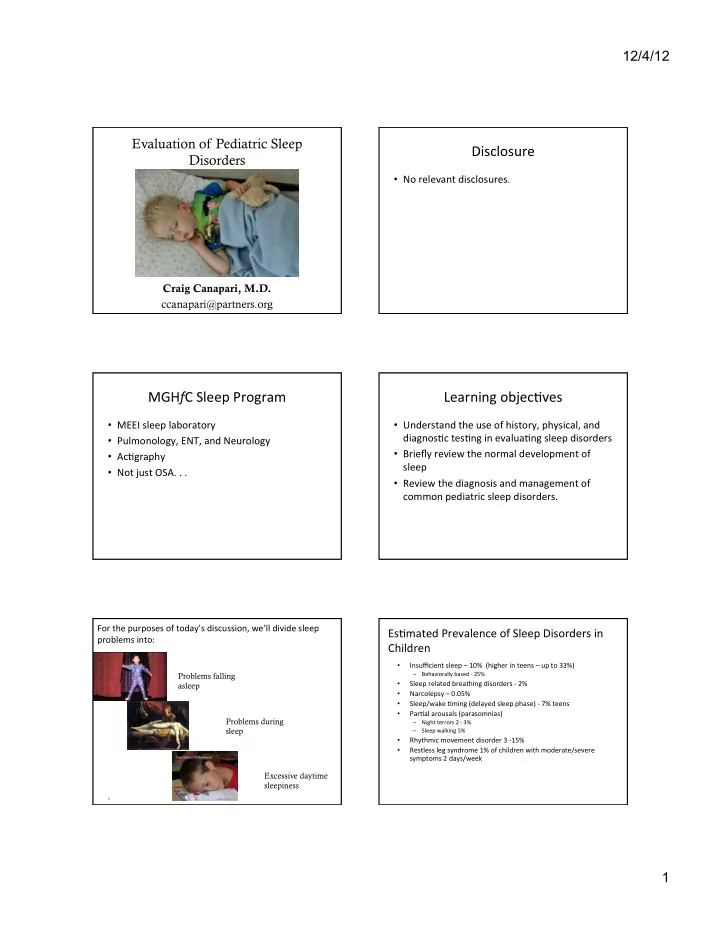

12/4/12 Evaluation of Pediatric Sleep Disclosure ¡ Disorders • No ¡relevant ¡disclosures. ¡ ¡ Craig Canapari, M.D. ccanapari@partners.org MGH f C ¡Sleep ¡Program ¡ Learning ¡objecBves ¡ • MEEI ¡sleep ¡laboratory ¡ • Understand ¡the ¡use ¡of ¡history, ¡physical, ¡and ¡ diagnosBc ¡tesBng ¡in ¡evaluaBng ¡sleep ¡disorders ¡ • Pulmonology, ¡ENT, ¡and ¡Neurology ¡ • Briefly ¡review ¡the ¡normal ¡development ¡of ¡ • AcBgraphy ¡ sleep ¡ • Not ¡just ¡OSA. ¡. ¡. ¡ • Review ¡the ¡diagnosis ¡and ¡management ¡of ¡ common ¡pediatric ¡sleep ¡disorders. ¡ ¡ ¡ For ¡the ¡purposes ¡of ¡today’s ¡discussion, ¡we’ll ¡divide ¡sleep ¡ EsBmated ¡Prevalence ¡of ¡Sleep ¡Disorders ¡in ¡ problems ¡into: ¡ Children ¡ • Insufficient ¡sleep ¡– ¡10% ¡ ¡(higher ¡in ¡teens ¡– ¡up ¡to ¡33%) ¡ – Behaviorally ¡based ¡-‑ ¡25% ¡ Problems falling Sleep ¡related ¡breathing ¡disorders ¡-‑ ¡2% ¡ • asleep • Narcolepsy ¡– ¡0.05% ¡ Sleep/wake ¡Bming ¡(delayed ¡sleep ¡phase) ¡-‑ ¡7% ¡teens ¡ • • ParBal ¡arousals ¡(parasomnias) ¡ Problems during – Night ¡terrors ¡2 ¡-‑ ¡3% ¡ ¡ sleep – Sleep ¡walking ¡5% ¡ Rhythmic ¡movement ¡disorder ¡3 ¡-‑15% ¡ • • Restless ¡leg ¡syndrome ¡1% ¡of ¡children ¡with ¡moderate/severe ¡ symptoms ¡2 ¡days/week ¡ Excessive daytime sleepiness ¡ 8 ¡ 1
12/4/12 The primary tool of assessing these problems is the Various tools are used in the assessment of sleep history you take in the office. disorders in children Sleep diaries Actigraphy Polysomnography A useful screening algorithm is BEARS: B = Bedtime problems E = Excessive daytime sleepiness A = Awakenings during the night Objective data about R = Regularity and sleep wake patterns http://bit.ly/cOn9RB duration of sleep. Subjective data Detailed about sleep wake cardiorespiratory, S = Snoring patterns EEG, and leg movement data for ¡ ONE night 11 ¡ 10 ¡ Generally, ¡parent ¡reports ¡of ¡sleep ¡ Sleep ¡pa_erns ¡ duraBon ¡reduce ¡with ¡Bme ¡ evolve ¡from ¡ birth ¡to ¡a ¡ typical ¡day/ night ¡cycle ¡in ¡ 4-‑6 ¡months ¡ From Iglowstein et al 2003 Sleep ¡needs ¡change ¡with ¡Bme ¡ Developmental ¡Overview ¡of ¡ ¡ Common ¡Sleep ¡Problems ¡ • Pre-‑school ¡(3 ¡to ¡5 ¡years) ¡ Newborn/ Older Infant – Sleep ¡needs: ¡11 ¡to ¡12 ¡hours ¡per ¡24 ¡hours ¡ Young Infant & Toddler Pre-schooler School Age Teenager – Naps: ¡Decrease ¡from ¡one ¡a ¡day ¡to ¡none ¡ Usually normal Night wakings Night wakings Insufficient sleep Insufficient – Clinical ¡Issues: ¡Sleep ¡onset ¡and ¡sleep ¡maintenance ¡problems ¡ sleep Developmental Difficulty settling Bedtime Bedtime common ¡in ¡this ¡age ¡group ¡ resistance resistance Delayed sleep Self limited Night terrors phase Night terrors Sleep walking • Pre-‑pubertal ¡(6 ¡to ¡12 ¡years) ¡ Rhythmic Narcolepsy movements Sleep walking Enuresis – Sleep ¡needs: ¡9 ¡to ¡11 ¡hours ¡per ¡24 ¡hours ¡ OSA Bedtime fears Rhythmic Bruxism movements – Naps: ¡DayBme ¡naps ¡are ¡NOT ¡normal ¡at ¡this ¡age ¡ OSA OSA Bedtime fears – Delayed ¡sleep-‑wake ¡Bming ¡– ¡later ¡bed ¡Bmes ¡ ¡ Nightmares • Teenagers ¡ OSA – Sleep ¡needs: ¡8.5-‑9.5 ¡hours ¡ – Further ¡physiologic ¡delay ¡in ¡sleep ¡onset ¡ 2
12/4/12 Problems falling asleep are among the most common in Physiologic awakenings are common at night pediatric practice The presentation varies with age and parent schedule Normal sleep architecture ¡ ¡ 16 ¡ 17 ¡ Inappropriate sleep onset association disorder is the The limit setting subtype of behavioral insomnia is classic pediatric behavioral disorder characterized by bedtime resistance and curtain calls Awakenings occur at times of physiologic arousal; recapitulation of bed time Bedtime may take an hour required or more. Curtain calls are comprised of requests for attention, water, backrubs, etc. Sleep is not generally not disrupted once onset occurs in the pure limit setting type. ¡ ¡ 18 ¡ 19 ¡ Extinction is very effective but challenging for parents to Bedtime modifications are also important and can help implement extinction succeed Positive bedtime routines and Unmodified: Close the door bedtime fading both entail and say goodnight transiently moving bedtime later to allow increased sleep drive to help with sleep onset. Graduated extinction: The Ferber method The bedtime pass is a good first pass method for limit setting disorders. Extinction with parental Reinforcement e.g. sticker charts presence Scheduled awakenings ¡ 21 ¡ ¡ 20 ¡ 3
12/4/12 “Camping ¡out” ¡can ¡work ¡as ¡well ¡with ¡slow ¡ Why ¡parents ¡fail ¡ withdrawal ¡of ¡parental ¡presence ¡ Parental inconsistency tends to reinforce the behaviors that they are trying in extinguish “ Sneaky sleep ” in the car, stroller, or wherever can reduce sleep drive at bedtime Inconsistent reinforcement is very potent. ¡ ¡ 24 ¡ 25 ¡ The extinction burst is a well described behavioral There ¡is ¡no ¡evidence ¡that ¡sleep ¡ phenomenon where a behavior worsens before it training ¡harms ¡children. ¡ ¡ ceases • AMH ¡Price ¡et ¡al ¡ Pediatrics ¡ Sept ¡2012 ¡ • There ¡was ¡no ¡evidence ¡that ¡children ¡who ¡had ¡sleep ¡training ¡ in ¡infancy ¡had ¡more ¡emo6onal ¡or ¡behavioral ¡problems ¡in ¡the ¡ children ¡who ¡were ¡not. ¡ • There ¡was ¡no ¡difference ¡in ¡the ¡stress ¡response ¡(measured ¡by ¡ cor6sol) ¡in ¡the ¡two ¡groups. ¡ ¡ • There ¡was ¡no ¡benefit ¡to ¡sleep ¡training ¡at ¡six ¡years ¡of ¡age ¡ either ¡ • For ¡more ¡on ¡this: ¡hAp://bit.ly/Q5qU2B ¡ The second night is frequently the worst, then things rapidly improve. ¡ 26 ¡ 4
Recommend
More recommend